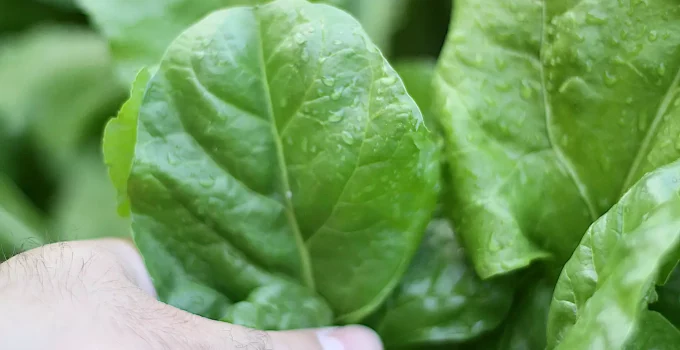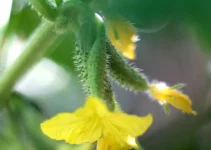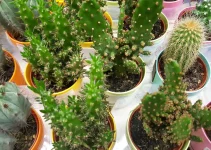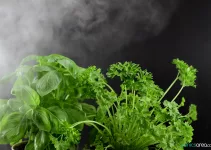In my guide on how to grow baby spinach I want to include both how to grow baby spinach indoors and outdoors.
For those who don’t have access to a garden or for those who don’t want to be restricted to growing it in spring or in the fall, growing indoors is absolutely possible.
As you can see, I definitely want to include everyone so that we can all enjoy a bountiful crop of baby spinach. I mostly eat it raw in my salads or in smoothies. I don’t actually like cooking this tiny leafy green, unless I make stir fry or frittata. It’s definitely worth growing.
Table of Contents
How to Grow Baby Spinach: What does baby spinach need to grow?
1. Seeds: Sow Right Seeds Viroflay Spinach Seed
This is an example of spinach seeds that will quickly grow some tiny leaves that will be just perfect for harvesting. In can expect to harvest in about 3 weeks. I also talk about other varieties below.
2. Containers: Zeonhak 6 Pack 17 Inches Countryside Flower Box Planters
If you don’t want to spend the money, grow in whatever containers, plastic boxes you have around the house. I prefer long rectangular planters for growing spinach at home indoors.
3. Potting soil: FoxFarm Ocean Forest Potting Soil Mix
I really love this one. It’s a blend of earthworm castings, bat guano, sea-going fish & crab meal, forest humus, moss and more.
4. Grow lights: GE Lighting LED Grow Light BR30
These are only needed if you’re growing indoors during the winter months where we have so many endless dark days. Even so, I selected one of the cheapest and most efficient grow lights for amateur growers. It’s just a bulb so you’ll need a lamp for it.
5. Fertilizer: Down to Earth Blood Meal Fertilizer Mix 12-0-0
I would say that it’s not needed if you have chosen a rich potting soil. Fertilizer is mostly recommended for growing spinach until maturity. Even so, if you want impressive growth, you can get this one since it’s organic.
How to Grow Baby Spinach Indoors in 8 Steps
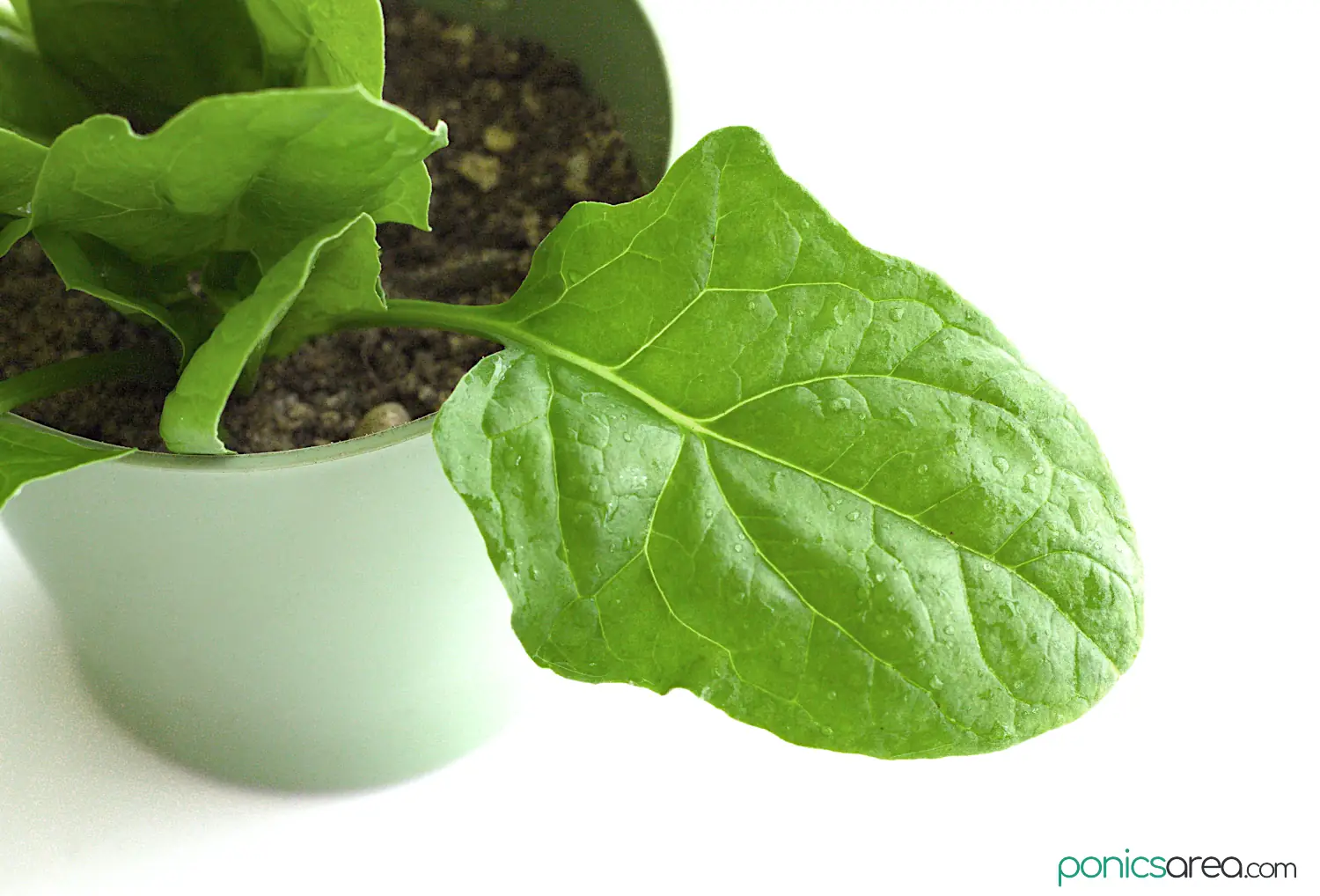
As long as the temperature indoors doesn’t run too hot, you shouldn’t have many problems with growing baby spinach indoors. Things can be quite simple, actually.
Since it doesn’t like long hot summer days, you can manage growing baby spinach indoors during the summer only if your AC runs every day to keep the temperature cool.
Otherwise, stick to spring, fall, and winter.
1. Sow the seeds in clumps of 2 or 3. The seeds should be sown ½ inches deep and 2 inches apart.
2. You should maintain a temperature under 75 degrees Fahrenheit (approx. 24 degrees Celsius).
3. Water thoroughly immediately after sowing. The soil will have to be kept moist all the time.
4. Place your containers on a window sill. Like any plant, it will need sunlight for rapid growth. Use grow lights if there’s not enough sunlight. In the beginning, run the lights for 14 hours per day.
5. Until the plants get established, you will have to water the soil daily but the soil must not get soggy.
6. As soon as the leaves grow a darker green, a bit stronger, and are the desired size that you want, you can harvest them. It can happen in 15-20 days after sowing the seeds. You can watch this cool spinach time lapse to get a better idea about the baby spinach growth rate.
7. When you’re ready to harvest, cut the leaves that are the desired size right at the base. The leaves will grow back and you might be able to get 2-3 harvests of baby spinach leaves. Each time they grow back, they will be less tender.
8. If you want a continuous supply of leaves, you can sow seeds in another container 2 weeks after starting the first one.
How to grow baby spinach indoors supplies
- seeds – I’ll talked about the best baby spinach varieties just after talking about how to grow baby spinach both indoors and outdoors
- container – you have a lot of freedom here: long rectangular planters work very well, they can easily fit on the window sill and you can plant seeds in many of them and have them spread out throughout the house or just choose whatever pots/containers you have and see how it goes or go for a 12-inch self-watering pot if you’re willing to spend the money
- rich potting soil/mix – you can get one that has a mix of compost and manure, these two components will provide the nitrogen that baby spinach needs for growing darker green leaves quickly and it will also ensure that the soil is well-drained
- grow lights – if you can’t place the container on a window sill that receives sunlight daily, you’ll also need grow lights if you plan on growing baby spinach indoors during winter
How to Grow Baby Spinach Outdoors in 6 Steps
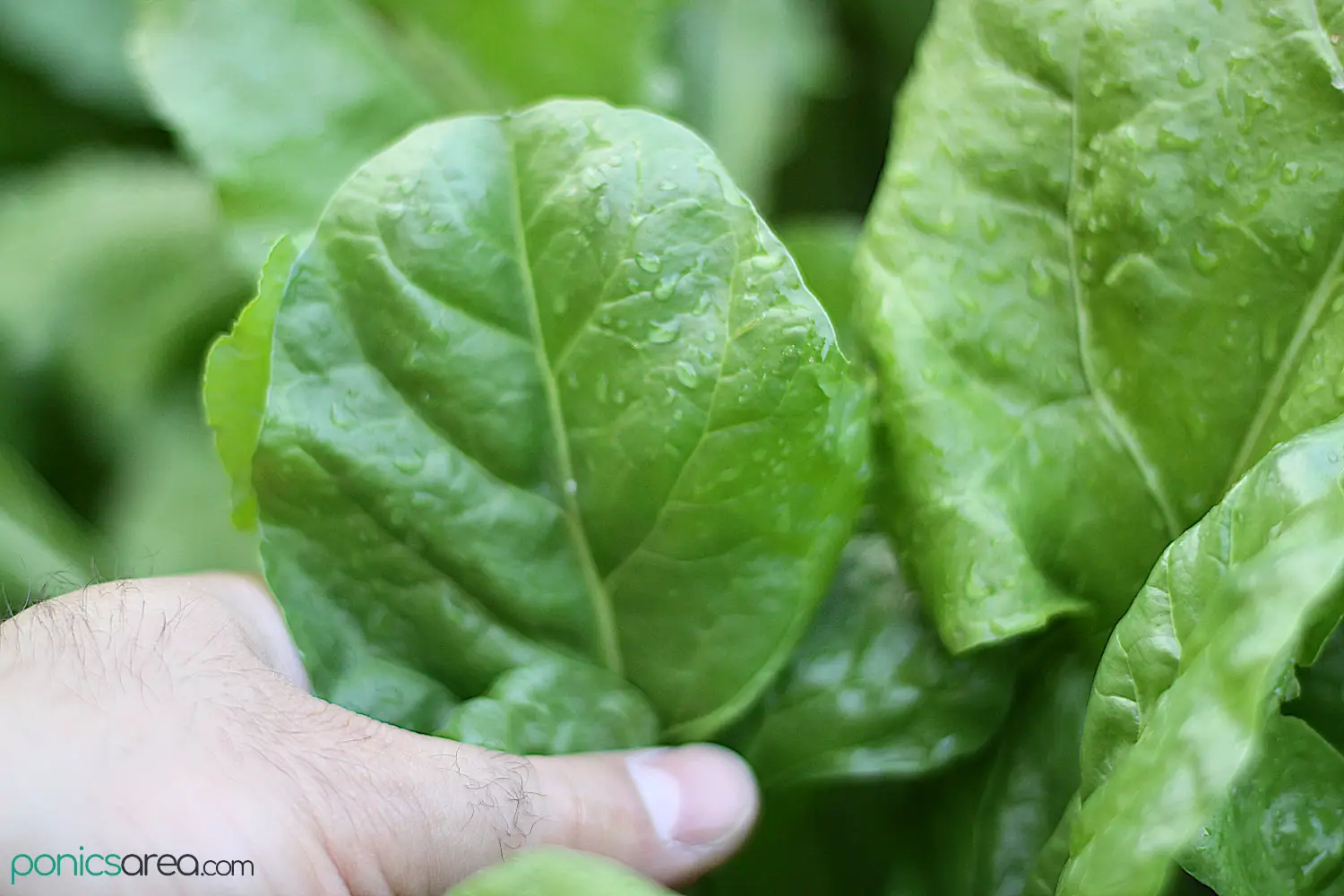
For those who have plenty of space in their gardens, growing leafy greens outdoors will be quite easy, especially if you’re using garden beds. When I’m talking about leafy greens, baby spinach is definitely included on the list.
So, if you know the generals about growing leafy greens, you pretty much don’t need to read this guide on how to grow baby spinach.
The one thing you must remember is that spinach doesn’t like hot temperatures. It can make it bolt, just like it’s the case with cilantro.
High temperatures and long summer days can make spinach plants produce seed stalks, which makes it unusable for food.
You can plant the spinach seeds directly in the soil or germinate the seeds and then transplant the seedlings.
Direct seedling is the preferred and the most successful method for growing baby spinach outdoors.
We’ll first cover each method for how to grow baby spinach outdoors and then move on to watering schedules, best soil, and the best fertilizer.
1. Can you sow spinach seeds directly?
You definitely can.
It’s actually the preferred method because the temperature indoors might be too hot for seeds to germinate successfully. Also, transplanting spinach seedlings can be a bit tricky.
Sow the seeds in rows in early spring, as soon as the soil can be worked.
Or in early/later fall, when the weather is not so hot.
The furrows should be 1/2 inches deep.
Sow the seeds about 1 inch apart down the bed.
Next, cover them with a very thin layer of soil or compost and water immediately after. Continue to water daily until the plants are established, it will take a while.
For fall crops, cover the seeds with sand to reflect heat and ensure a cooler soil.
You can start your fall crop by sowing the seeds in late summer, as soon as the soil starts cooling a bit.
You can actually make succession plantings every week or once every 2 weeks. It will ensure that you have a fresh supply of baby spinach leaves until the weather gets too hot and it bolts.
2. How to germinate spinach seeds
Germinating spinach is tricky because the temperatures need to be quite low. It’s usually done only if the soil is too wet to allow for direct sowing of the seeds.
If you have any experience with germination, you just need to remember that this leafy green doesn’t need warm germination temperatures, which happens for most plants.
The first thing you need to establish is when you should germinate spinach seeds if you’re growing outdoors.
Germination is started in early spring so that the seedlings can be transplanted as early as the soil can be worked.
You can start to germinate 3 to 6 weeks before the last frost.
The other two times for transplantation are early or later in the fall.
This is how you germinate spinach seeds:
- use whatever containers you have in the house, use germination trays or use a long rectangular planter
- you can sow the seeds in clumps of 2 or 3 – you can remove the weaker seedlings after they grow a bit
- sow the seeds 2 inches apart right on top of the soil – if you’re using germination trays, plant 2 seeds per cell, once the seedlings appear, you can cut the weaker one
- you can then cover the seeds with about half an inch of soil
- moisten the soil with a watering can or just pour gently from a cup/glass
- maintain the temperature between 40 to 75 degrees Fahrenheit – it’s best if it’s cooler
- if the soil gets too hot, germination can definitely fail
- how long does it take until spinach germinates depends on the room temperature, the average is 6 to 10 days but it can take as long as 3 weeks at 50 degrees F
3. Transplanting the seedlings
If you first want to enjoy the baby spinach leaves and then let the plant mature, then you can plant one seedling per square foot. That will give it a lot of room to grow. Otherwise, you can transplant them close.
Once the seedlings are in the soil, you need to thoroughly water them immediately after. And then, water every single day for a week until the plants are established.
Just below, I also talk about how to use fertilizer for spinach plants.
4. Watering: Consistent Moisture
If you didn’t know by now, leafy greens need water. Consistent moisture is the factor that will get them to thrive. It’s why growing hydroponic lettuce is so easy, because it enjoys all that water. The same goes for spinach, since they’re both leafy greens.
When you’re transplanting the seedlings, you need to water them thoroughly.
After planting, you’ll have to water the seedlings every single day for a week.
Once the seedlings are established, you’ll need to water thoroughly each week. Only stop watering when the soil is completely soaked.
You mustn’t allow the plants to wilt.
5. Soil
If consistent moisture is one of the top conditions that you should meet, you can’t do that without growing in adequate soil.
The soil is the one that will hold onto the moisture, while at the same time ensuring optimal drainage so that there’s no root rot.
It’s also the one that provides all the nutrients for a bountiful, healthy crop.
So, based on all this, the best soil for baby spinach contains compost, it is a soil rich in organic matter.
If you can take things even further, you can also make a mix of manure and compost. This type of mix, if it’s added to sandy soils, it will bind them and to clay soil, it will increase drainage.
It’s best if you prepare the ground by adding compost and/or manure to it.
6. Do You Need Fertilizer for Growing Baby Spinach?
For your first crop, if you’re using a nutrient-rich soil, you can let the soil provide the needed nutrients and see how that goes.
It can work for baby spinach because we only desire small, tender leaves. You can definitely try first without using any fertilizer.
I would say that baby spinach doesn’t need additional fertilizer if you have picked a rich potting mix and it receives plenty of light and moisture.
But what about if you want to see the plant reach maturity? According to Texas A&M University, spinach grows best when given plenty of fertilizer.
If you’re not in the mood for experimenting with how successful a soil is on its own, you should use a fertilizer for additional nutrients, mostly nitrogen.
Since leafy greens only produce leaves and no fruits or bulbs or vegetables, the additional feeding is focused on nitrogen. However, too much can cause leaf tip burn.
If you want to add extra feeding, the best fertilizer for spinach will be a nitrogen rich fertilizer or you can use an all-purpose plant food.
The best fertilizer for spinach is:
- all-purpose granulated type (organic slow release fertilizer) – this type is added directly to the soil or next to the plant in granulated form, it’s not dissolved in water
- soluble granulated fertilizer (dissolved in water), which provides instantly available nutrients to plants
- or use 5-1-1 fish fertilizer
There are some people who use all these 3 types of fertilizer. How does it go? I discovered this method while searching on YouTube. You can watch this video to see the exact instructions.
When making the trenches, you can add all-purpose granulated fertilizer to the soil. This will be released slowly and it will enrich the plant throughout its growth cycle. Then the seedlings are planted.
After the soil is thoroughly watered, a bit more granulated fertilizer is added for each plant. Then, the plants are watered a second time.
After that, the soluble fertilizer is dissolved according to instructions and fish fertilizer is added to it. The spinach is then water with this mix, too.
You can fertilize spinach once every 2 weeks with the granulated type and every 7 to 14 days with the other two types.
Baby Spinach vs Spinach
Baby spinach and spinach are the same plant, you won’t need to buy different seeds for these two because they’re absolutely the same.
You just need to get seeds for flat smooth-leaved spinach varieties. This is the most popular type around the world. The other two are savoy and semi-savoy. For our guide, we are interested in the flat-leaf varieties.
The difference in these two is that one is harvested when it has smaller, more tender leaves.
So, baby spinach can be harvested even after 15-20 days of plant growth. It depends on how big you like your tender leaves, you have plenty of freedom here.
In order to reach maturity, the spinach plant is left to grow for much longer. It will be harvested 45-60 days after planting.
The one thing you should keep in mind, besides providing it with plenty of water, is that spinach is a cool weather crop. No hot, long summer days for this one.
Flat smooth-leaf spinach varieties
- Olympia – fast growing, slow to bolt, very good for spring or early summer planting, one of the most popular
- Space – a flat leaf variety with dark green, round, spoon-shaped leaves, bolt resistant, awesome for both summer and fall harvest, a top amazing choice as a baby spinach variety, you can also get the organic Space seed
- Red Snapper – the leaves actually resemble arugula, they have red veins with unique, lobed and serrated leaves, an intriguing alternative to the classic baby spinach crops but just as tender, juicy, and delicious
If you want to increase the harvesting season and your chance of having a bountiful crop, you can focus on getting disease resistant, slow to bolt varieties.
Another thing you should know is that the seeds are not viable for long. You should always buy a new package for the year you’re planting. It also ensures that germination will go perfectly.
I know that I have included a lot of information in my how to grow baby spinach at home guide but, in the end, you just need to keep in mind the fundamentals: temperatures under 75 degrees Fahrenheit, consistent moisture, nutrient-rich soil with compost and manure in the mix, access to sunlight.

